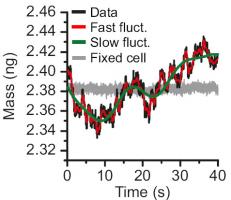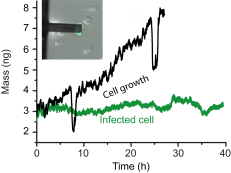Nature 550, 500–505
David Martínez-Martín, Gotthold Fläschner, Benjamin Gaub, Sascha Martin, Richard Newton, Corina Beerli, Jason Mercer, Christoph Gerber & Daniel J. Müller (October 26, 2017)
In this paper, David Martínez-Martín and his colleagues from the Biophysics group of the ETH Zürich introduce a technology they invented to allow tracking the mass of cells in real time. Using this technology, they were able to observe that the mass of living mammalian cells intrinsically fluctuates by around 1–4% over timescales of seconds throughout the cell cycle. Perturbation experiments link these mass fluctuations to the basic cellular processes of ATP synthesis and water transport. They also show that growth and cell cycle progression are arrested in cells infected with vaccinia virus, but mass fluctuations continue until cell death.
The published data suggest that all living cells show fast and subtle mass fluctuations throughout the cell cycle, and illustrate how the described technology could become an important tool for use in biophysics, cell biology, physiology, and medicine, to investigate in detail how cells regulate their mass in various cell states.
Nanosurf established a partnership with David Martínez-Martín and Daniel J. Müller to make this promising technology available to the scientific community by developing it into a product that can be used by a wider audience. For details on the instrument, see the PicoBalance tab on the DriveAFM product page.
Related content
Images reproduced with permission of Daniel Mathys (University of Basel), David Martínez-Martín (ETH Zürich), and Nature




